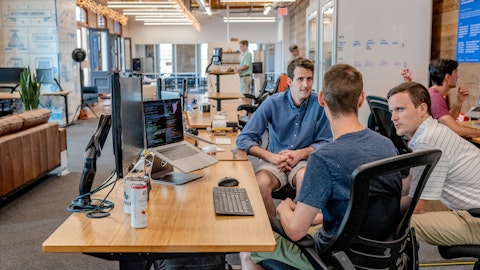Kenneth Stillwell: Sure. So maybe it’s interesting to paint the picture. When we first started the Pega Cloud the first couple of years, our gross margin was 35%, then it was 45%. Then it was 50%. And then when it was about 50%, we set a target of 70%. And now that we’ve surpassed them, and then we moved the target to 75%, a couple of years ago, and then we kind of said, well maybe we could do high 70s. And so naturally that can’t go on forever, of course, right? Because at some point, you do hit a point where the efficiency is got to stabilize. But I think like best in class SaaS companies would strive to have gross margins that begin with an eight, right? And so we want to be best in class, and we’re starting to get some good scale. So I think 75 to high 70s is maybe a mile marker on that journey to being a best in class SaaS company from gross margin standpoint. Maybe that’s the way I’ll frame it.
Alan Trefler: I would just throw in, that the way this has been achieved, has been to excellent collaborative work of the team both in terms of putting extensive automation into our cloud operations that both save money but also make the system more reliable and more effective for our clients. Being able to rework so you may have heard me talk about Project Phoenix, actually about five years ago is when we talked about that. We have to rework the system to be cloud oriented and micro services oriented architecture. There is a lot of what I would describe as non-financially related improvements that go beyond just what we would get from scale. And that’s what makes me excited and things that we can’t raise the bar forever. But we do have a little more we can go.
Richard Poland: Thank you. Very helpful, guys.
Operator: Next question, Steve Enders with Citi. Please go ahead.
Steve Enders: All right, great. Thanks for taking the question here. I guess maybe just following up on the AI discussion. I guess how do you think about where you have a right to win, and will be kind of focusing on your AI initiatives and embedding that in the product versus maybe looking at the rest of the technology ecosystem and partnering with other technology vendors or third parties to embed some of that functionality into your products set.
Alan Trefler: Well, we’re definitely building our generative capabilities to be able to partner. We talked about the partnership with AWS. Partnership with the other major AI providers also is central to how we’re going to go to market. So we see being able to use the super rapidly emerging large language model capabilities that are going to continue to evolve as something that needs to be part of our open architecture there. We, of course, also have some of our own AI capabilities, when it comes to what we call the customer decision hub. And what we call process AI which is the ability to use AI in processes to be able to make them learning and self optimizing which is not really a generative technology, but is also very powerful from both benefit and a cost savings and a customer service perspective.
So I feel really well-equipped to be able to be a significant player not that we’re going to come up with something super general because I think that’s going to be an insanely competitive space, but within types of customers that we know we can serve, that have enterprise needs that actually fit perfectly with the types of things we’re considering and doing. We’re getting great feedback from the early clients are showing us that we’re absolutely on the right track and going to be delivering things here that there would be excited to use.
Steve Enders: Okay, understood and appreciate the thoughts there. I guess mean, for Ken really good cash flow in the quarter, and kind of accounted for half of the initial guide that you put out for the year there. Was there anything one time in nature that maybe not pulling into the quarter or anything that we should be thinking about it as we think about cash, the paper cash flow throughout the rest of the year here going forward?
Kenneth Stillwell: Yes, sure. Steve, just a reminder that, typically, our billings are higher in Q4 and Q1 which would mean that our collections would be typically higher in Q4 and Q1. Now, that said, we do have a lot of cash outlays in Q1 because like, for example, we have our annual CICP payment that goes out. We have, so we have a higher, it’s a higher payment of a commission quarter typically, because Q4s are typically higher in bookings. So there were some offsets to that, but I would say Q4 and Q1 are typically stronger, free cash flow quarters, and Q2 and Q3 are typically less strong just because of the nature of our bookings and billings. But that said, Q1 was very strong in terms of free cash flow.
Steve Enders: Okay, appreciate the great answer there. Thanks again for taking the questions.
Kenneth Stillwell: Sure.
Operator: Next question, Jake Roberge with William Blair. Please go ahead.
Jake Roberge: Hey, thanks for taking my questions. Alan, just wanted to dig deeper into your comment that generative AI could commoditize lower end low code use cases. Could you just talk a little bit more about what Pega’s history in the AI world and its positioning and more mission critical workflows help you really take advantage of the opportunities from the AI team moving forward?
Alan Trefler: Well, sure, and I also can just explain why I think our positioning and our technology provides a moat that is consistent with our enterprise approach. When Pega goes into a customer, the types of things we talked about with a “low code” customer is we talked about building a low code app factory what does that mean? Well, that means I’m able to build apps quickly. But it also means the apps have a structure that lets them be hooked together, that doesn’t have them be really isolated things. And that also lets them leverage the other enterprise assets, like the interfaces, like some of the controls, the other types of things that are going to be either consistent or related across apps. This ability to have what we call a layer cake, where certain things go across the entire customer enterprise and other things might vary with say different divisions of a bank or of an insurance company, or that might vary with types of work, or applications, those all fit into a cake.
They run in a way that really is complementary to each other. I think that really lends itself to being super distinguished from companies that have just a bunch of little apps running around. And any company that’s been betting their future on generating low code apps, that do kinds of simple things, or that run on a mobile device, we’ve experimented with generating little mobile apps that are actually quite remarkable in some ways that look exactly like the demos from some of our competitors. I think that you’re going to find the market is really going to, it’s going to end up really shaking out the market. Because I think is just going to go away.
Jake Roberge: Very helpful. Thanks for that color, and then Ken how do you feel about the pace of your subscription transition at the start of this year? Have you seen any impact of the migration as a result of the macro? And do you feel like Pega is still on track to complete the transition this year and be a role for the business as you exit 2024?
Kenneth Stillwell: So the subscription, those are good questions. I’m going to tease a couple of them out first. The subscription transition pace, I think is I’m very happy with it. There has been some maybe it took a little longer to get through the kind of financial transformation subscription, probably by six months to a year than what I had originally kind of envisioned in my mind. I thought it would take four to five years, or like five to six years, but in general, close enough, but it, so I think that went well. Not every client is going to want Pega Cloud. let’s just that’s an important way, it really ties to our cloud choice. Now, we want every client to have Pega Cloud. But the reality is not everyone has the used case, or may choose to want to manage it themselves, depending on lots of things that might be decided within their environment.
But that’s okay. But I think it’s such a significant amount of our clients will. In terms of clients, who’ve chose to move workloads on to Pega Cloud, I mean, we have not pushed clients, or in some cases, forced clients, like other companies have done to say you have no choice, you must move, because we understand that our clients and our relationship is different than the typical software company. And we need to be respectful of how much, how mission critical the Pega applications are, and how hard it might be to just shift over to another environment. That said, we do have clients, every kind of year, every quarter having those conversations and some have begun to move and some move new workloads. The most important thing for us, I think, though, is that two thirds of our clients have seen Pega Cloud meaning they may not have all of their stake on Pega Cloud, but they have something there.
And I think that they know the value. And over time that migration, as you mentioned, will happen what to the extent that the clients kind of want to. In terms of the economic kind of maybe if you have headwind in the economy, does that mean people move or not move to Pega Cloud. I think it’s kind of like the maybe the punch line of your question. And I would say that really depends on whether the client views a movement to a vendor cloud, like Pega Cloud is going to solve some other financial inefficiencies that they may have, or some optimization that they may have inside their organization. That is absolutely true for some of our clients. For other clients, they may not be ready to move, because they may not have, they may not want to use some of those resources in the short term to make that move.
So I would say that last part, it really depends, I would say, overall, the economic environment probably is a little bit helpful to have clients think about Pega Cloud when it’s a tougher environment. But that’s not a universal point.





